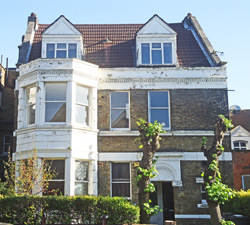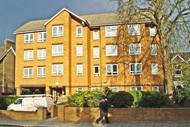Specialist
In 1918 the Streatham Babies Hospital opened in a small private house at No. 39 Riggindale Road. It had 18 cots and provided care for malnourished and delicate babies and children up to 5 years of age who had been referred from various Infant Welfare Centres in the Borough of Wandsworth, an area of poverty and high unemployment.
By 1921 the Hospital had 20 cots and beds, including two isolation cots. The little patients mainly suffered from marasmus, gastroenteritis and bronchitis. The babies were fed on modified cow's milk. Their average length of stay was 22 days and they were cared for by a Matron, two staff nurses and three probationers. A domestic servant was also employed. The parents paid 10 shillings (50p) a week for their infant's keep, but necessitous cases were admitted free or at a reduced fee.
The rooms were small and on several floors with many stairs. It was hoped to be able to build a purpose-built hospital. However, in 1926, the Hospital Trustees - a committee of ten, led by Lady Gertrude Parsons - decided it would be impossible to raise funds to purchase a site and build a new hospital. Instead, a suitable detached house, Easdale, at No. 9 Leigham Court Road was purchased in December for £2,500.
A 10-year contract was signed with the Ministry of Health, and the house was refurbished and equipped with 20 beds at a cost of £2,000.
The 2-storey house faced southwest and was set well back from the road. It had a basement, a garage and a large garden. The large conservatory was used as a 'summer' ward and it was intended that a shelter be built in the grounds.
The ground floor contained three wards of 8, 5 and 4 cots. The large Billiard Room, also on the ground floor, was divided into three cubicles for observation cases. The nurses' bedrooms were on the first and second floors, while the basement housed the kitchen, the staff dining room and the scullery (but it was so dark that artificial light had to be used).
In 1928 a Stanley Cox Trilite lamp was purchased to provide sunlight treatment for children suffering from bronchitis and otorrhoea. In 1929 the Hospital realized £35 16s 5d (£35 82p) from the sale of silver paper and tinfoil collected by its supporters. At this time the cost of an in-patient was £2 12s 11d (£2 63p) a week (in 1930 this rose to £2 14s 0d (£2 70p)).In 1931 a sunshine verandah was built as an annexe, creating a playground for the patients. During the year the Hospital was quarantined four times because of outbreaks of scarlet fever. Patients with scarlet fever were transferred to other hospitals, as were those who had tuberculosis or needed surgery. The Hospital continued to treat children with nutritional disorders due to poor feeding, marasmus, malnutrition, prematurity or Pink's disease; respiratory, gastrointestinal and genitourinary diseases; and debility following illness or surgery.
In 1932 an extra observation cubicle was built, giving a total of 21 beds. The nursing staff had increased, and there was a Matron and a Sister, two staff nurses and six probationers.
In 1935, without permission, the Hospital installed a window with 'obscure' glass in the side wall of the ground floor, looking out on the grounds of No. 7. A neighbourly dispute broke out, and was resolved the following year, when the Hospital agreed to pay the owner of No. 7 the sum of one shilling (5p) a year not to block the light to this window. The Hospital also paid the cost of £2 3s 0d (£2 15p) for preparing the agreement.
By the late 1930s further development of Leigham Court Road had taken place with many small shops being built at the northwest end. These shops were numbered 1A through to 1H, and 3 through to 3D. The local authority decided the whole road needed to be renumbered, and thus the Hospital's address changed from No. 9 to No. 45 Leigham Court Road. By this time it was also known as the Borough of Wandsworth Babies Hospital (its President was the Mayoress of Wandsworth and it received an annual grant from the Borough).
The Hospital closed in 1940 following the outbreak of WW2 and the premises were used by the Central Hospital Supply Service throughout the war.
In 1943 the Trustees had declared the Hospital building to be worth less than £4,000. However, in December 1946, it was valued at £6,100 for insurance purposes, and the annual premium was renewed at a cost of £7 17s 6d (£7 87p). In the same month the Charity Commissioners approved the charity's plans to sell the property, provided they received at least £7,000 for it.
In 1947 the South London Hospital for Women
acquired the property and it seems to have remained in the hands of the
Ministry of Health and used for hospital purposes until 1969, when it
passed to the Home Office.
Present status (December 2008)
The original building has been demolished and a 4-storey apartment block, South Lodge, built in its place in 1987. South Lodge has 25 apartments and provides sheltered housing for retired Jewish residents. As part of the same development the South London Synagogue was built at the rear of the building.

The first location of the Hospital at No. 39 Riggindale Road.

Easdale in Leigham Court Road has been demolished and its site now contains South Lodge, an apartment block.
http://apps.nationalarchives.gov.uk
http://discovery.nationalarchives.gov.uk
http://wellcomelibrary.org (1)
http://wellcomelibrary.org (2)
Return to home page